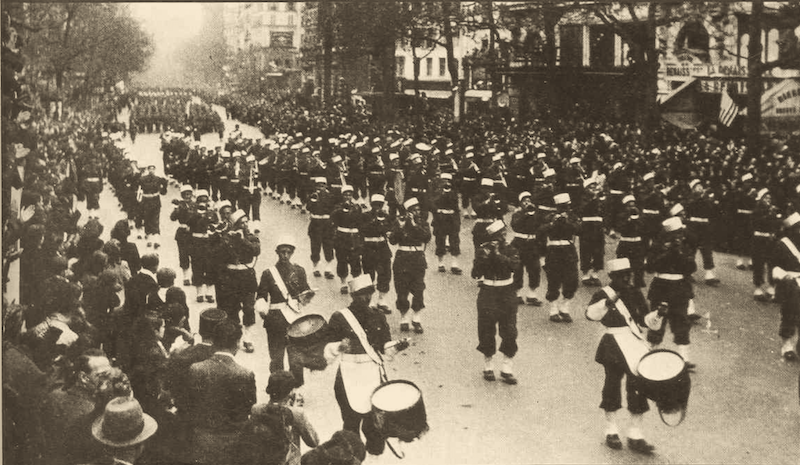Origin and Unit Identification
Following photo I could recently purchase via Delcampe.fr.
It shows a military band which is easy to be identified as from the French Foreign Legion.
More specific it is the band of the Regiment de Marche de la Legion Etrangere.
The identification was easy because of the clearly visible letters R.M.L.E. on what the French call the “Tabliers de Tambour”.
I cropped the picture, since the original shows a lot of empty road, most likely because the person taking the photo was standing in the crowd on the other site of the road.

When and Where ?
Unfortunately nothing is written on the reverse of the photo that gives an indication of when and where the photo was taken. However, on the image itself some shops are visible, prominent in the middle “Alaska Furs” and most likely on the left “(B)onne Nouvelle”.
The broadness of the road seems to point towards a major city, first best guess Paris.
[ GRANDE RECLAME DE MODELES FOURRURES ALASKA-FURS 11 , boulevard Bonne-Nouvelle, 11 Choix de jaquettes, manteaux, toutes fourrures, canadiennes, pour le sport, spécialiste des manteaux d’enfants ]
French Foreign Legion Military Band Literature; Raymond Guyader
Writing about Military Bands, seems not to be top priority of Military Historians.
But fortunately the history of the Musique of the French Foreign Legion was addressed by the French Historian Raymond Guyader in a series of articles in the magazine of the Legioen “Kepi Blanc”.
In two volumes KB497 and KB498 Guyader wrote about the “musique du R.M.L.E.” though with a special emphasis on the “Tabliers de Tambour et Flammes de Clairon” as the title indicates.
Brief history of the musique du R.M.L.E.
Guyader wrote in the “premiere partie” that the “musique regimentaire” was formed at around the same time when the regiment de marche de la Legion etrangere was formed July 1943.
The batterie, as it is called, consisted of 12 tambours, six fifres, and about 18 clarions which divided the musique by two cymbales, one grosse caisse and one chapeau chinois. (This chapeau chinois is clearly visible on the image).
In the deuxième partie, Guyader quotes from the book “C’est la Legion” by Colonel Louis Gaultier and Colonel Charles Jacquot.
Colonel Gaultier recalled that end November 1944 the regiment could not count on its band.
It did not seized to exist, but was severely reduced because due to significant losses on the battlefield musicians had to participate in the fighting with their bataillons.
To solve the issue, de Chef de Musique came with the idea, to recruit from the French Provinces in the Nord, for the duration of two years young musicians from villages since each mine there had a orphéon.
Finally the managed to gather 140 young, Picards, Artesiens and Flamands.
At a great military parade held on the 7th of February 1945 in Colmar the celebrate de liberation, the legionairs and these “military musicians” could show their talent.
[Note this distinction made between legionairs and military musicians].
Another great performance was at the 18th of June 1945 at the victory parade in Paris.
Written is:
“Ils sont a nouveau tres applaudis lors du defile da la victoire, a Paris, le 18 juin 1945”
At present it is most likely that the images above was taken during this parade.

The RMLE was dissolved the first of July 1945.
Guyader ends his articles indicating that on the 25th of april 1946, the 3eme Etranger embarked for Saigon.
This unit who inherited the tradition of the RMLE continued to use the RMLE “Tabliers de Tambour et Flammes de Clairon” for several months.